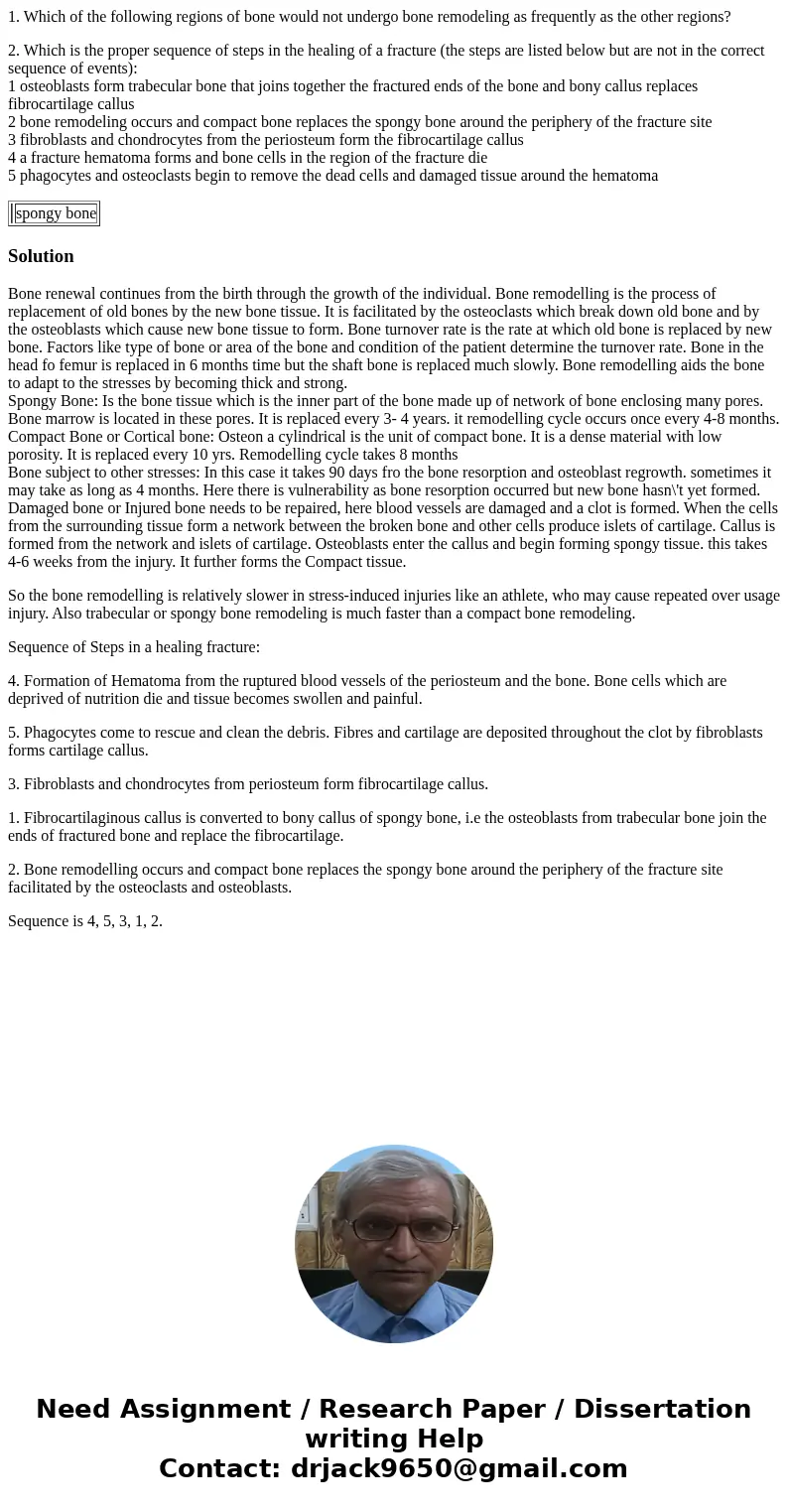1 Which of the following regions of bone would not undergo b
1. Which of the following regions of bone would not undergo bone remodeling as frequently as the other regions?
2. Which is the proper sequence of steps in the healing of a fracture (the steps are listed below but are not in the correct sequence of events):
1 osteoblasts form trabecular bone that joins together the fractured ends of the bone and bony callus replaces fibrocartilage callus
2 bone remodeling occurs and compact bone replaces the spongy bone around the periphery of the fracture site
3 fibroblasts and chondrocytes from the periosteum form the fibrocartilage callus
4 a fracture hematoma forms and bone cells in the region of the fracture die
5 phagocytes and osteoclasts begin to remove the dead cells and damaged tissue around the hematoma
| spongy bone |
Solution
Bone renewal continues from the birth through the growth of the individual. Bone remodelling is the process of replacement of old bones by the new bone tissue. It is facilitated by the osteoclasts which break down old bone and by the osteoblasts which cause new bone tissue to form. Bone turnover rate is the rate at which old bone is replaced by new bone. Factors like type of bone or area of the bone and condition of the patient determine the turnover rate. Bone in the head fo femur is replaced in 6 months time but the shaft bone is replaced much slowly. Bone remodelling aids the bone to adapt to the stresses by becoming thick and strong.
Spongy Bone: Is the bone tissue which is the inner part of the bone made up of network of bone enclosing many pores. Bone marrow is located in these pores. It is replaced every 3- 4 years. it remodelling cycle occurs once every 4-8 months.
Compact Bone or Cortical bone: Osteon a cylindrical is the unit of compact bone. It is a dense material with low porosity. It is replaced every 10 yrs. Remodelling cycle takes 8 months
Bone subject to other stresses: In this case it takes 90 days fro the bone resorption and osteoblast regrowth. sometimes it may take as long as 4 months. Here there is vulnerability as bone resorption occurred but new bone hasn\'t yet formed.
Damaged bone or Injured bone needs to be repaired, here blood vessels are damaged and a clot is formed. When the cells from the surrounding tissue form a network between the broken bone and other cells produce islets of cartilage. Callus is formed from the network and islets of cartilage. Osteoblasts enter the callus and begin forming spongy tissue. this takes 4-6 weeks from the injury. It further forms the Compact tissue.
So the bone remodelling is relatively slower in stress-induced injuries like an athlete, who may cause repeated over usage injury. Also trabecular or spongy bone remodeling is much faster than a compact bone remodeling.
Sequence of Steps in a healing fracture:
4. Formation of Hematoma from the ruptured blood vessels of the periosteum and the bone. Bone cells which are deprived of nutrition die and tissue becomes swollen and painful.
5. Phagocytes come to rescue and clean the debris. Fibres and cartilage are deposited throughout the clot by fibroblasts forms cartilage callus.
3. Fibroblasts and chondrocytes from periosteum form fibrocartilage callus.
1. Fibrocartilaginous callus is converted to bony callus of spongy bone, i.e the osteoblasts from trabecular bone join the ends of fractured bone and replace the fibrocartilage.
2. Bone remodelling occurs and compact bone replaces the spongy bone around the periphery of the fracture site facilitated by the osteoclasts and osteoblasts.
Sequence is 4, 5, 3, 1, 2.

 Homework Sourse
Homework Sourse